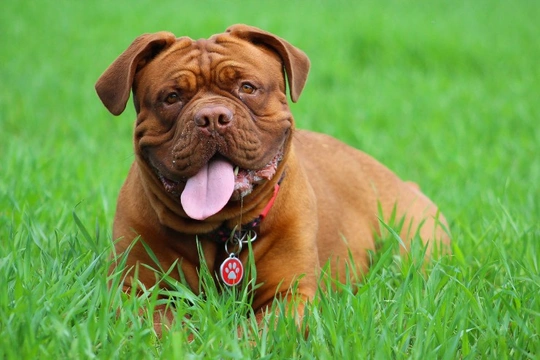
Digital hyperkeratosis (DH) health testing for the Dogue de Bordeaux
The Dogue de Bordeaux is a large, stocky and very muscular dog breed with a grumpy-looking but cute face and an all business demeanour! Dogs of this breed were originally prized for their confidence and boldness, as one of their first working roles was to assist hunters to bring down large prey, and to protect livestock and families from predators.
The Dogue de Bordeaux is a breed that is imposing to look at and that can certainly hold its own if threatened, but they are also very loving and affectionate dogs that form strong bonds with their owners and that are loyal to the end. They are often very protective of their families and can be quite speculative around people and dogs that they don’t know, but when properly socialised, are obedient, well mannered and quiet as a general rule.
There are a number of very positive aspects to Dogue de Bordeaux ownership that make this large breed popular with people from all walks of life. They need sufficient exercise to keep them happy and fulfilled, but they are not among the most high energy of breeds that can be something of a handful to manage within the home. They are quite tolerant of being left alone at home for reasonable periods of time if all of their needs are fulfilled, and they’re also above average in the intelligence stakes, which usually makes them reasonably easy to train.
However, one of the negative sides of the breed is that they don’t tend to live for as long as the average dog, and there are a number of hereditary heath issues that can be found within the Dogue de Bordeaux breed as a whole as well.
One such condition is called digital hyperkeratosis or DH, and this is an inherited health condition that affects the dog’s paws. Whether or not any given dog will develop digital hyperkeratosis or have a propensity to pass the condition on to their own offspring if bred from is something that can be identified by means of DNA testing, and anyone considering breeding from a Dogue de Bordeaux is advised to test their breeding stock for the markers of the condition before going ahead with a mating match.
In this article we will look at digital hyperkeratosis in the Dogue de Bordeaux breed in more detail, and explain how owners of dogs of the breed can find out the status of their own dogs with DNA testing. Read on to learn more.
What is digital hyperkeratosis?
Digital hyperkeratosis or DH is also sometimes known by the alternative names of hereditary footpad hyperkeratosis, or corny feet. The condition affects the pads of the dog’s paws, leading to them becoming thicker and harder than normal, which in turn makes the paw pads prone to cracking and splitting, which is both painful and greatly increases the risk of an infection setting in.
In some presentations of digital hyperkeratosis in the Dogue de Bordeaux, the dog’s nails will also grow faster than normal, which leads to malformations and weak claws that are prone to breaking and crumbling.
All of these factors mean that a Dogue de Bordeaux with digital hyperkeratosis needs special care on the part of their owners to maintain their feet and claws and keep them healthy and in good condition, but dogs with digital hyperkeratosis can normally lead normal, happy lives once the condition is properly managed and controlled.
How is digital hyperkeratosis in the Dogue de Bordeaux inherited?
Digital hyperkeratosis in the Dogue de Bordeaux is a hereditary health condition that develops due to a genetic mutation. This means that the condition is not contagious, and a dog can only develop digital hyperkeratosis if they inherit a certain combination of gene faults for it from their parents.
Dogue de Bordeaux digital hyperkeratosis is passed from dog to dog by means of autosomal recessive heredity, which means that if you know the status of a dog’s parents (which can be found out with DNA screening) you will also be able to work out whether or not any members of their litter may be affected by the condition.
Here’s how different combinations of parent dog status can affect the status of their litter:
- An affected dam and sire will have an affected litter.
- A clear dam and sire will have a clear litter.
- A carrier dam and carrier sire will produce a litter of 50% carriers, 25% clear and 25% affected.
- One clear parent and one affected parent will produce a litter of carriers.
- A clear parent and a carrier parent will produce a litter of 50% clear pups and 50% carriers.
- A carrier parent and an affected parent will produce a litter of 50% carriers and 50% affected pups.
DNA health screening for digital hyperkeratosis in the Dogue de Bordeaux breed
You can’t tell just by looking at a dog’s feet if they might be clear of or a carrier of digital hyperkeratosis, and you can’t always tell even if a dog is affected by the condition if symptoms are not apparent, or have not yet developed.
However, in order to enable Dogue de Bordeaux breeders to find out the status of their own dogs and make healthy mating matches, a DNA test can be performed to identify the status of individual dogs of the breed.
To get your Dogue de Bordeaux tested for the markers of digital hyperkeratosis, you just need to ask your vet to take a DNA sample from your dog, and to send it away to an approved laboratory for analysis.
The results – either clear, carrier or affected – will then be returned to you directly.



